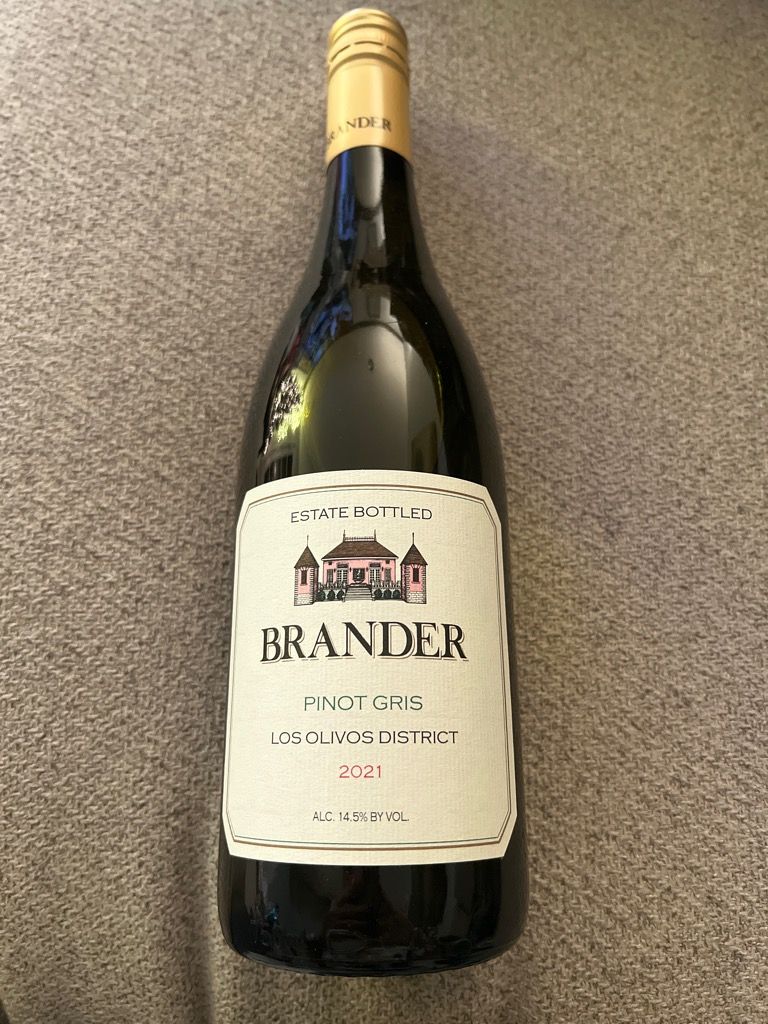
External search
Google (images)
Wine Advocate
Wine Spectator
Burghound
Wine-Searcher
Vintages
2021
2017
2012
2009
From this producer
Show all wines
All tasting notes
|
| Drinking Windows and Values |
| Drinking window: not specified |
| Community Tasting History |
| Brander Producer websitePinot GrisFrom Pinot Gris Wikipedia entry:
Wines made from the Pinot gris vary greatly and are dependent on the region and wine making style they are from. Alsatian Pinot gris are medium to full bodied wines with a rich, somewhat floral bouquet. They tend to be spicy in comparisons with other Pinot gris. While most Pinot gris are meant to be consumed early, Alsatian Pinot gris can age well. German Pinot gris are more full-bodied with a balance of acidity and slight sweetness. In Oregon the wines are medium bodied with a yellow to copper-pink color and aromas of pear, apple, and/or melon. In California, the Pinot gris are more light bodied with a crisp, refreshing taste with some pepper and arugula notes. The Pinot grigio style of Italy is a light-bodied, often lean wine that is light in color with sometimes spritzy flavors that can be crisp and acidic. Although this wine can be very sweet, it will begin to lose its acidity when it is nearly ripe.
Pinot gris is considered an "early to market wine" that can be bottled and out on the market within 4–12 weeks after fermentation.
Varietal character (Appellation America)
Conseillé pour l'apéritif et avec les mets suivants :
Foie Gras terrine
Foie Gras poęlé
Tarte tatinUSAAmerican wine has been produced since the 1500s, with the first widespread production beginning in New Mexico in 1628. Today, wine production is undertaken in all fifty states, with California producing 84% of all U.S. wine. The continent of North America is home to several native species of grape, including Vitis labrusca, Vitis riparia, Vitis rotundifolia, and Vitis vulpina, but the wine-making industry is based almost entirely on the cultivation of the European Vitis vinifera, which was introduced by European settlers. With more than 1,100,000 acres (4,500 km2) under vine, the United States is the fourth-largest wine producing country in the world, after Italy, Spain, and France.California2021 vintage: "Unlike almost all other areas of the state, the Russian River Valley had higher than normal crops in 2021, which has made for a wine of greater generosity and fruit forwardness than some of its stablemates." - Morgan Twain-Peterson Central Coasthttp://www.ccwinegrowers.org/links.html
http://www.discovercaliforniawines.com/regional-wine-organizations/
http://beveragetradenetwork.com/en/btn-academy/list-of-winegrowers-association-in-central-coast-california-274.htm
Central Coast AVA WikipediaSanta Ynez ValleyThe Santa Ynez Valley AVA is the largest wine sub-region of Santa Barbara County and has the highest concentration of vineyards. The valley runs from east to west, between the Purisima Hills and the San Rafael Mountains in the north, and the Santa Ynez Mountains in the south. Although the valley is open to the Pacific Ocean in the west, the fact that it is relatively narrow means that limited cool air and fog is funnelled in. Low average rainfall and a very long growing season make the region ideal for quality wine production.
The diverse climates of Santa Ynez Valley mean that a wide array of wines is produced. The cool, western part of the AVA is predominantly planted with Pinot Noir and Chardonnay, accompanied by other aromatic white varieties. Botrytis cinerea (noble rot) is able to flourish here, allowing some outstanding dessert wines to be produced in suitable vintages. Further east, the cooling effect of the ocean is lessened as both vineyard elevation and average temperatures increase. This warmer part of Santa Ynez Valley is more suited to fuller-bodied grape varieties, such as Syrah and Merlot.
more ...s expected, Chardonnay and Pinot Noir thrive, while the more inland zones lay claim to Bordeaux varietals and some Rhone blends. |
|


